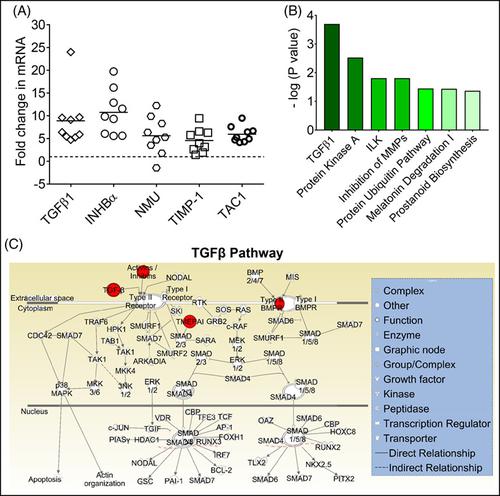当前位置:
X-MOL 学术
›
Genes Brain Behav.
›
论文详情
Our official English website, www.x-mol.net, welcomes your
feedback! (Note: you will need to create a separate account there.)
Transcriptomic approach predicts a major role for transforming growth factor beta type 1 pathway in L-Dopa-induced dyskinesia in parkinsonian rats.
Genes, Brain and Behavior ( IF 2.4 ) Pub Date : 2020-08-02 , DOI: 10.1111/gbb.12690 Shetty Ravi Dyavar 1 , Lisa F Potts 2 , Goichi Beck 2 , Bhagya Laxmi Dyavar Shetty 2 , Benton Lawson 1 , Anthony T Podany 3 , Courtney V Fletcher 3 , Rama Rao Amara 1 , Stella M Papa 2, 4
Genes, Brain and Behavior ( IF 2.4 ) Pub Date : 2020-08-02 , DOI: 10.1111/gbb.12690 Shetty Ravi Dyavar 1 , Lisa F Potts 2 , Goichi Beck 2 , Bhagya Laxmi Dyavar Shetty 2 , Benton Lawson 1 , Anthony T Podany 3 , Courtney V Fletcher 3 , Rama Rao Amara 1 , Stella M Papa 2, 4
Affiliation

|
Dyskinesia induced by long‐term L‐Dopa (LID) therapy in Parkinson disease is associated with altered striatal function whose molecular bases remain unclear. Here, a transcriptomic approach was applied for comprehensive analysis of distinctively regulated genes in striatal tissue, their specific pathways, and functional‐ and disease‐associated networks in a rodent model of LID. This approach has identified transforming growth factor beta type 1 (TGFβ1) as a highly upregulated gene in dyskinetic animals. TGFβ1 pathway is a top aberrantly regulated pathway in the striatum following LID development based on differentially expressed genes (> 1.5 fold change and P < 0.05). The induction of TGFβ1 pathway specific genes, TGFβ1, INHBA, AMHR2 and PMEPA1 was also associated with regulation of NPTX2, PDP1, SCG2, SYNPR, TAC1, TH, TNNT1 genes. Transcriptional network and upstream regulator analyses have identified AKT‐centered functional and ERK‐centered disease networks revealing the association of TGFβ1, IL‐1β and TNFα with LID development. Therefore, results support that TGFβ1 pathway is a major contributor to the pathogenic mechanisms of LID.
中文翻译:

转录组学方法预测转化生长因子 β 1 通路在左旋多巴诱导的帕金森病大鼠运动障碍中的主要作用。
帕金森病中长期左旋多巴 (LID) 治疗引起的运动障碍与纹状体功能改变有关,其分子基础尚不清楚。在这里,转录组学方法被用于综合分析纹状体组织中独特调控的基因、它们的特定途径以及 LID 啮齿动物模型中的功能和疾病相关网络。这种方法已将转化生长因子 β 1 (TGFβ1) 确定为运动障碍动物中高度上调的基因。基于差异表达的基因(> 1.5 倍变化和P < 0.05),TGFβ1 通路是 LID 发育后纹状体中最重要的异常调节通路。TGFβ1通路特异性基因、TGFβ1、INHBA、AMHR2的诱导和PMEPA1也与调控有关的NPTX2,PDP1,SCG2,SYNPR,TAC1,TH,TNNT1基因。转录网络和上游调节器分析已经确定了以 AKT 为中心的功能和以 ERK 为中心的疾病网络,揭示了TGFβ1、IL-1β和TNFα与 LID 发展的关联。因此,结果支持 TGFβ1 通路是 LID 发病机制的主要贡献者。
更新日期:2020-08-02
中文翻译:

转录组学方法预测转化生长因子 β 1 通路在左旋多巴诱导的帕金森病大鼠运动障碍中的主要作用。
帕金森病中长期左旋多巴 (LID) 治疗引起的运动障碍与纹状体功能改变有关,其分子基础尚不清楚。在这里,转录组学方法被用于综合分析纹状体组织中独特调控的基因、它们的特定途径以及 LID 啮齿动物模型中的功能和疾病相关网络。这种方法已将转化生长因子 β 1 (TGFβ1) 确定为运动障碍动物中高度上调的基因。基于差异表达的基因(> 1.5 倍变化和P < 0.05),TGFβ1 通路是 LID 发育后纹状体中最重要的异常调节通路。TGFβ1通路特异性基因、TGFβ1、INHBA、AMHR2的诱导和PMEPA1也与调控有关的NPTX2,PDP1,SCG2,SYNPR,TAC1,TH,TNNT1基因。转录网络和上游调节器分析已经确定了以 AKT 为中心的功能和以 ERK 为中心的疾病网络,揭示了TGFβ1、IL-1β和TNFα与 LID 发展的关联。因此,结果支持 TGFβ1 通路是 LID 发病机制的主要贡献者。











































 京公网安备 11010802027423号
京公网安备 11010802027423号